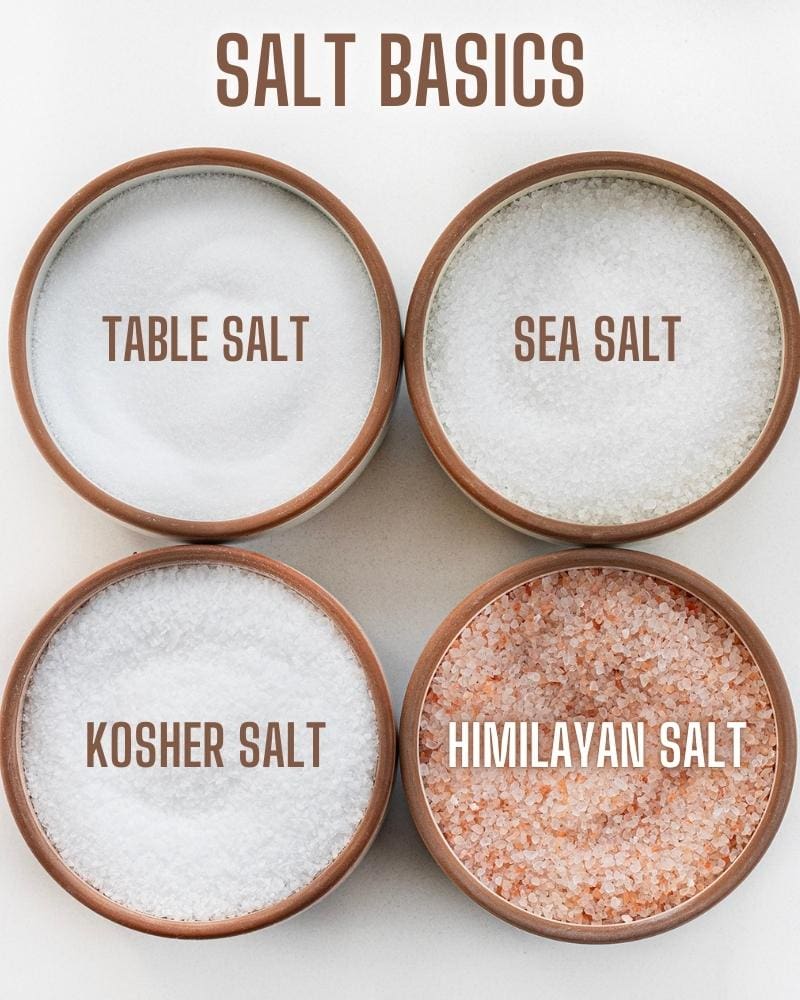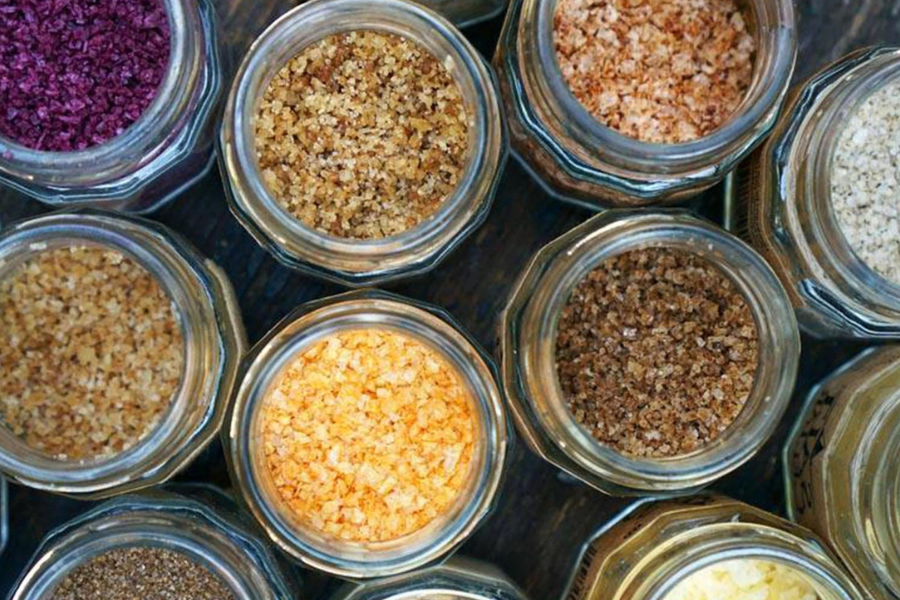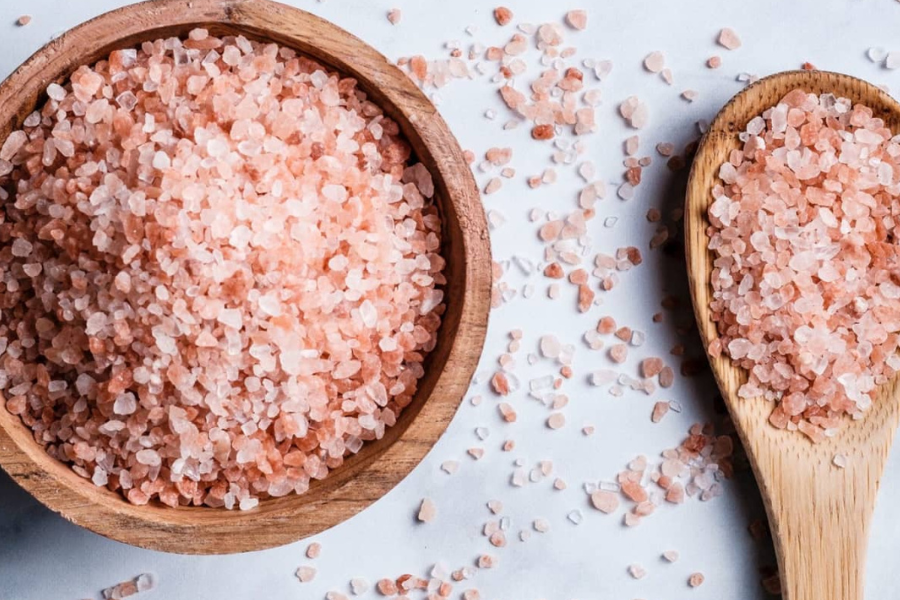
You may hear about or read that salt has positive or negative effects on your body, however, I’m here to set the record straight. It’s important to have an understanding of how much salt to eat in order to maintain health. The U.S. Food and Drug administration recommends that adults limit sodium intake to less than 2,300 mg per day—that’s equal to about 1 teaspoon of table salt.
Even though it has a bad reputation, humans need salt to survive. While the average American over consumes the compound, cutting it out completely could have detrimental effects. The electrolytes in salt are responsible for both water retention and keeping the fluid ratio of the body in check. In addition, it aids in the transmission of nerve impulses. Without salt, we would struggle to function, so it’s important to enjoy it in moderation.
Kinds of Salt
There are basically 4 categories of salt:
Table salt, sea salt, kosher salt, and Himalayan salt. Lets break them down.
TABLE SALT (Avoid this one when possible)
The most common and typical salt used in the U.S. is table salt. If you look at many of the ingredient labels of the different brands of table salt you will likely find three or four ingredients listed. Those ingredients are salt (sodium chloride), calcium silicate or other anti-caking agent, dextrose (sugar) and if iodized, potassium iodide.
Let’s look at the problems with this type of salt. To begin, table salt has been refined – chemically stripped of beneficial minerals which are referred to as “impurities,” leaving only sodium chloride. This salt is then bleached through another chemical process and then anti-caking agents are added. These anti-caking agents consist of more chemicals.
Dextrose is then added as a stabilizer to enable the iodine to stay in the salt and most likely to make it more addicting (my opinion). With diabetes affecting a large percentage of the population these days, eating a bit of sugar every time you salt your food cannot be a good thing. It’s no wonder salt has a bad rap! You basically have a lifeless and worthless product that is only good for one thing — ensuring a long shelf life.
Photo Below: Colorful Sea Salts From Different Parts of the World

SEA SALT
Sea salt is produced through evaporation of ocean water and water from sea lakes. It involves minimal processing and may contain trace minerals such as magnesium, calcium, and potassium. With less processing comes the possibility of more impurities like lead. According to the American Heart Association (AHA), sea salt has a coarse texture and may contain less sodium due to the larger size of the crystals. It is not recommended for baking because the large crystals create uneven measurement.
Distilled from the ocean, sea salt can be coarse or finely ground. This variety also varies in color, depending on what minerals are present (Pink Himalayan sea salt, for example, gets its color from trace minerals like iron and magnesium). Because the process of mining it is more complex (flakes are collected from evaporated seawater), the price of sea salt is usually higher than your regular table salt.
A Few Types of Sea Salt
CELTIC SEA SALT
Celtic sea salt originates from the coastal area near Brittany, France. It always remains a greyish damp salt no matter the conditions because of its moist nature. After collecting from the seashore, it is dried in wind and sunlight. It contains less quotient of sodium as compared to table salt with some significant amount of trace minerals.
FLEUR DE SEL
Fleur de sel is salt that forms on the surface of seawater as it evaporates. Traditional French Fleur de sel comes from the coast of Brittany in France. Other countries often discarded this salt historically, but the rise of gourmet culture has seen a rise in countries harvesting it – specifically Spain and areas in Mexico. When harvested from that region, they are termed “Flor de sal.” This type of salt is used as a finishing salt.
CYPRES BLACK LAVA SEA SALT
If you’re looking for a salt with a strong, salty flavor, then black lava salt is a great option. This type of salt is harvested from the Mediterranean Sea near the island of Cyprus. It’s then aged in natural volcanic rock, which gives it its distinct black color.
HAWAIIN RED ALAEA SALT
This type of sea salt is harvested from the ocean near the Hawaiian Islands. It’s blended with red alaea clay, which gives it a unique pinkish-red color. It has a mild flavor that pairs well with fish and seafood dishes.
ENGLISH MALDON SALT
This type of sea salt is harvested in the UK and is known for its large, pyramid-shaped crystals. It has a subtle flavor and is perfect for finishing dishes like salads and seafood.
Photo of Kosher Salt

KOSHER SALT
Kosher salt has large, coarse grains that come from salt deposits. Kosher salt was originally used to get blood out of meat and make it kosher.
Kosher salt is made of sodium chloride and does not contain additives or iodine like table salt. While iodine can be helpful for thyroid health, it can have a metallic kind of taste. Some people are turned off by table salt for this reason. Since it is not iodized, Kosher salt is pure and doesn’t include the bitter flavor of iodine.
Kosher salt is typically sold in either coarse or fine textures. There are two main brands that sell kosher salt: Mortons and Diamond Crystal.
Kosher salt is often used in the process of cooking. It can’t be directly substituted for table salt because it is lighter. Kosher salt can be used while making dishes or as a finishing touch. Aside from cooking, kosher salt can also be used in cleaning or to keep food fresh.
Photo of Pink Himalayan Salt

PINK HIMALAYAN SALT
Pink Himalayan salt is a truly unique salt. It’s also referred to as pink salt, Himalayan sea salt, rock salt and Himalayan crystal salt. With a history dating back to Earth’s creation, Himalayan salt is believed to be composed of dried remnants of the original, primal sea. Despite the name, Himalayan pink salt is more commonly sourced from mines in Pakistan, although some mines do exist in other Himalayan regions. The distinct pink hue of Himalayan salt is caused by mineral impurities. That’s right, there are no additives or processes to give the salt it’s flamboyant pink color, it is mined straight from underground.also includes a reported 84 different essential and trace minerals like calcium, magnesium, potassium, copper, and iron. Because Pink Himalayan Salt is jam-packed with minerals, it also touts enhanced health benefits.
In conclusion, I’m a big fan of salts in general, however, I avoid table salt. I have a couple of salt graters and have Himalayan salts in both so I use this one the most.
If your doctor tells you limit your salt intake, listen to him or her and know that you can use a little bit of kosher salt, sea salt, or Himalayan salt—these salts have benefits!
Did you learn anything? I always do when researching healthy topics. Of course, now I want to get out and try different types of salt—a ton of choices. How about you?
Adrienne
xo
Nourish Your Way to Health cookbook only uses and recommends using the good salts.

Loved this information!!
Thank you!!
Thanks Joey, you’re welcome. ☺️